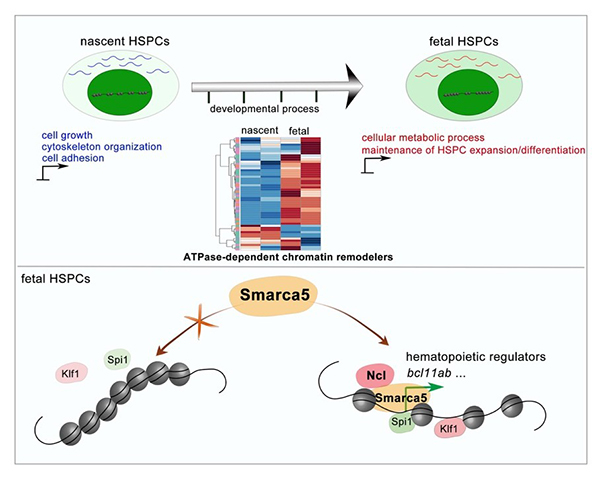Hematopoiesis can produce all types of blood cells, including erythrocyte, megakaryocyte, macrophage, and lymphoid cells, etc. These cells are derived from the hematopoietic stem and progenitor cells (HSPCs), which are capable of self-renewal and multi-lineage differentiation 1-3. In vertebrates, the earliest definitive HSPCs (i.e., nascent HSPCs) arise from the ventral wall of dorsal aorta in the aorta-gonad-mesonephros (AGM) region, through the endothelial-to-hematopoietic transition 4-6. Then, nascent HSPCs migrate into a transient fetal hematopoietic organ, fetal liver (FL) in mammals or caudal hematopoietic tissue (CHT) in zebrafish, for rapid expansion/differentiation (i.e., fetal HSPCs) 7-8. Previous studies in mice have revealed that most nascent pre-HSCs are immature, and these cells acquire the complete transcriptome signature of definitive HSCs only when they colonize the FL 9-10. Moreover, transplantation assays have shown that nascent HSPCs, susceptible to immune-rejection, preferentially engraft mouse neonates for effective transplant outcomes 11. Given that there are substantial molecular and phenotypical differences between nascent- and fetal HSPCs, understanding the intrinsic mechanism facilitating fetal HSPC development can help improve the strategy to generate functional HSPCs in vitro.
In August 2020,Feng Liu (from Institute of Zoology, Chinese Academy of Sciences) and Yong Zhang (from Tongji University) groups collaborate on a paper entitled Smarca5 mediated epigenetic programming facilitates fetal hematopoietic stem and progenitor cell development in vertebrates in BLOOD journal. This work identifies dynamic chromatin accessibility underlies transcriptional program differences between nascent- and fetal HSPCs. Mechanistically, Smarca5 interacts with Nucleolin to promote chromatin remodeling and facilitate genomic binding of hematopoietic TFs in fetal HSPCs.
Firstly, they profiled the chromatin accessibility landscape and transcriptome feature by performing Assay for Transposase-Accessible Chromatin with high-throughput sequencing (ATAC-seq) and RNA sequencing (RNA-seq) analyses in nascent- and fetal HSPCs of zebrafish. Data analysis uncovers the dynamic chromatin accessibility and transcriptional program differences between nascent- and fetal HSPCs. They also find that the dynamic chromatin accessibility at promoters is important for nascent-to-fetal HSPC transition. Specifically, the higher percentage and expression level of hematopoietic genes within accessible chromatin regions in fetal HSPCs implies that nascent HSPCs are acquiring robust definitive characteristics upon transitioning into fetal HSPCs.
Systematical screening of chromatin remodeler-related genes identifies that Smarca5 is required for the maintenance of chromatin accessibility at promoters of hematopoiesis-related genes, which are responsible for the maintenance of HSPC expansion and differentiation. Mass spectrometry and functional analysis show that Smarca5 interacts with Nucleolin (Ncl) to promote chromatin remodeling, thereby facilitating genomic binding of transcription factors to regulate expression of hematopoietic regulators such as bcl11ab.
Taken together, these results unravel a new role of epigenetic regulation in HSPCs at different developmental stages and reveal that Smarca5-mediated epigenetic programming is responsible for fetal HSPC development. This work was supported by the National Key Research and Development Program of China, the Strategic Priority Research Program of the Chinese Academy of Sciences, China and the National Natural Science Foundation of China. This study was supported by the State Key Laboratory of Membrane Biology, China and Translational Medical Center for Stem Cell Therapy and Institute for Regenerative Medicine, China.

Smarca5 mediated epigenetic programming facilitates fetal hematopoietic stem and progenitor cell development
Figure legend: The development of HSPCs from nascent to fetal states undergoes dynamic changes in chromatin accessibility and transcriptome features, accompanied by the dynamic expression of chromatin remodelers. Further study identifies Smarca5, in collaboration with a co-remodeler Ncl, is able to mediate chromatin accessibility to promote genomic binding of hematopoietic TFs, such as Klf1 and SPI1, which further activate the expression of target genes during fetal HSPC development. For instance, deletion of smarca5 leads to the decreased chromatin accessibility at bcl11ab promoters, which contains sites with Spi1 motif, thereby results in HSPC developmental defects in CHT.
References
1.Laurenti E, Gottgens B. From haematopoietic stem cells to complex differentiation landscapes. Nature. 2018; 553(7689):418-426.
2.Orkin SH, Zon LI. Hematopoiesis: an evolving paradigm for stem cell biology. Cell. 2008; 132(4):631-44.
3.Zhang YF, Gao S, Xia J, et al. Hematopoietic Hierarchy - An Updated Roadmap. Trends in Cell Biology. 2018; 28(12):976-986.
4.Bertrand JY, Chi NC, Santoso B, et al. Haematopoietic stem cells derive directly from aortic endothelium during development. Nature. 2010; 464(7285):108-U120.
5.Kissa K, Herbomel P. Blood stem cells emerge from aortic endothelium by a novel type of cell transition. Nature. 2010; 464(7285):112-U125.
6.Boisset JC, van Cappellen W, Andrieu-Soler C, et al. In vivo imaging of haematopoietic cells emerging from the mouse aortic endothelium. Nature. 2010; 464(7285):116-U131.
7.Murayama E, Kissa K, Zapata A, et al. Tracing hematopoietic precursor migration to successive hematopoietic organs during zebrafish development. Immunity. 2006; 25(6):963-75.
8.Xue YY, Lv JH, Zhang CX, et al. The Vascular Niche Regulates Hematopoietic Stem and Progenitor Cell Lodgment and Expansion via klf6a-ccl25b. Dev Cell. 2017; 42(4):349-+.
9.McKinney-Freeman S, Cahan P, Li H, et al. The Transcriptional Landscape of Hematopoietic Stem Cell Ontogeny. Cell Stem Cell. 2012; 11(5):701-714.
10.Rybtsov S, Ivanovs A, Zhao SL, et al. Concealed expansion of immature precursors underpins acute burst of adult HSC activity in foetal liver. Development. 2016; 143(8):1284-1289.
11.Arora N, Wenzel PL, McKinney-Freeman SL, et al. Effect of Developmental Stage of HSC and Recipient on Transplant Outcomes. Dev Cell. 2014; 29(5):621-628.
(Contact: Feng Liu, liuf@ioz.ac.cn)

